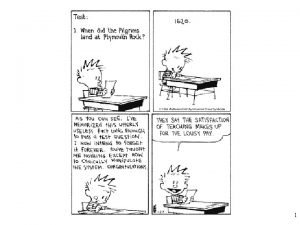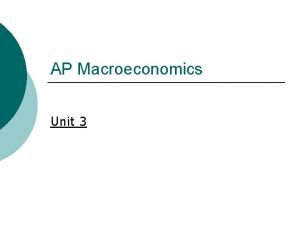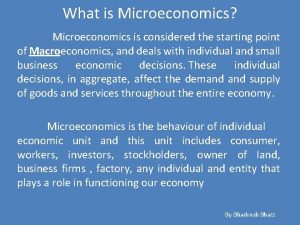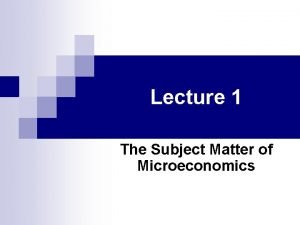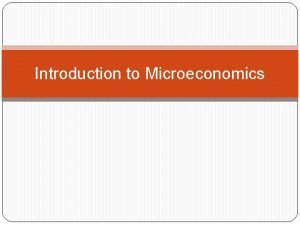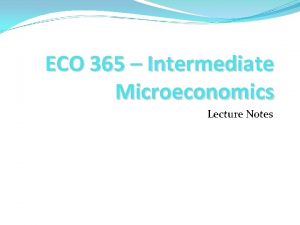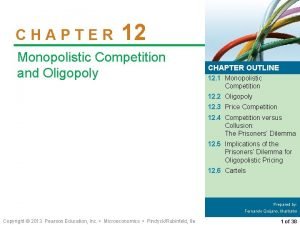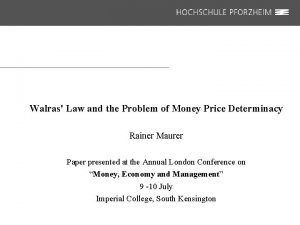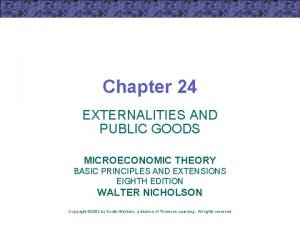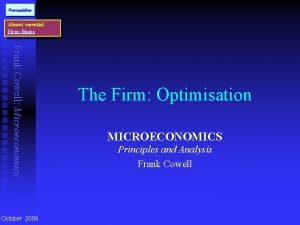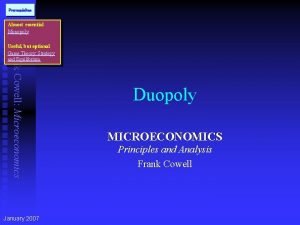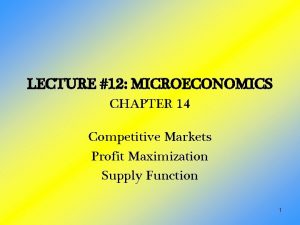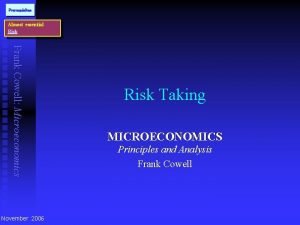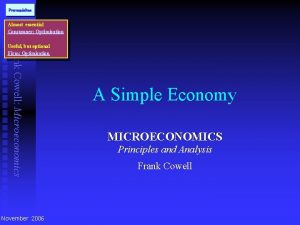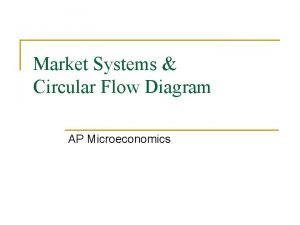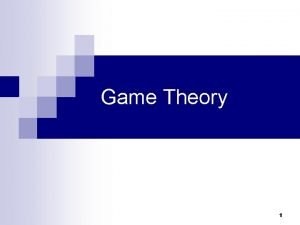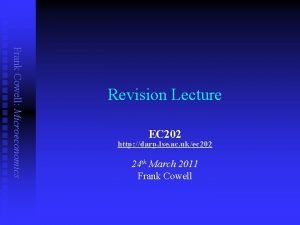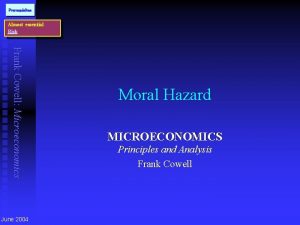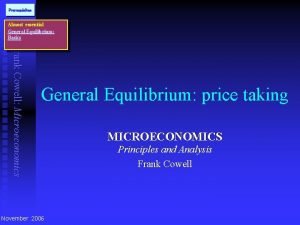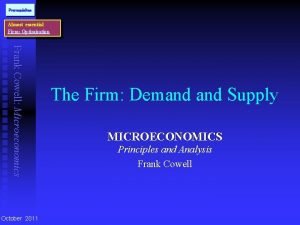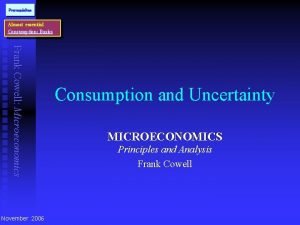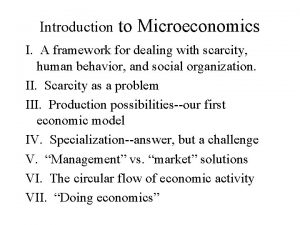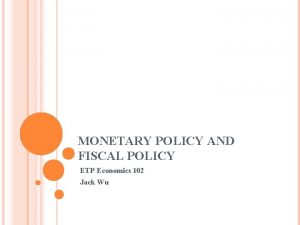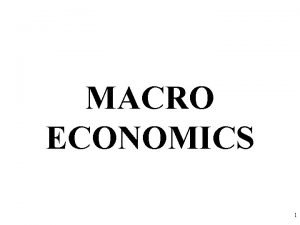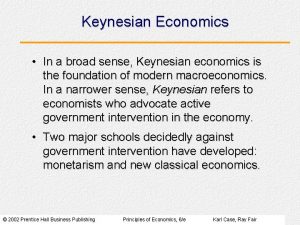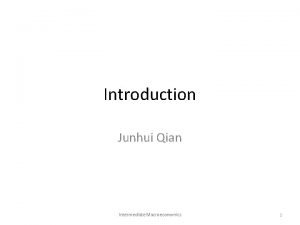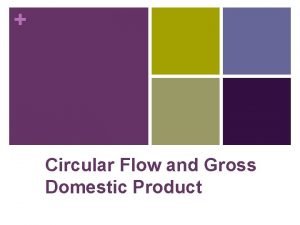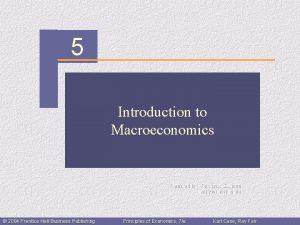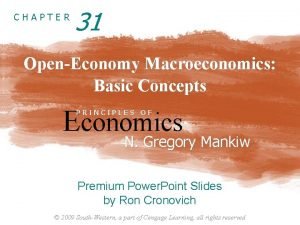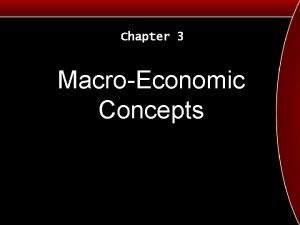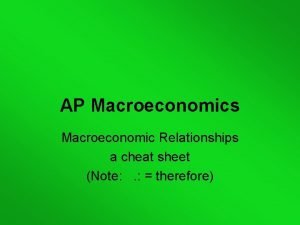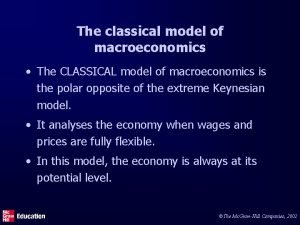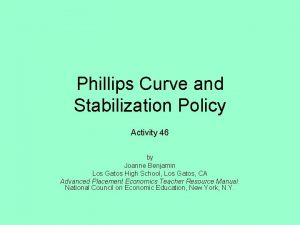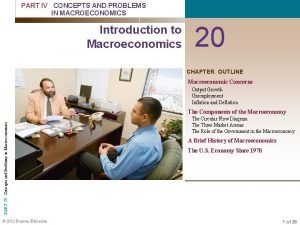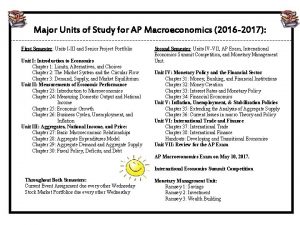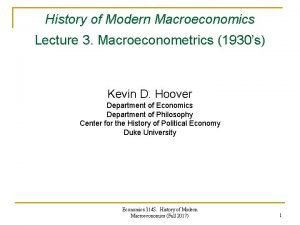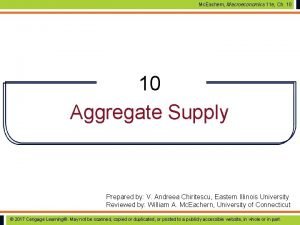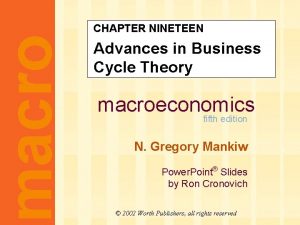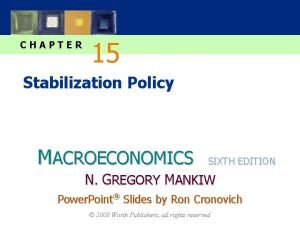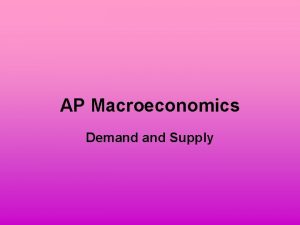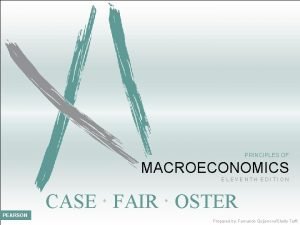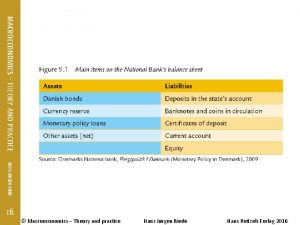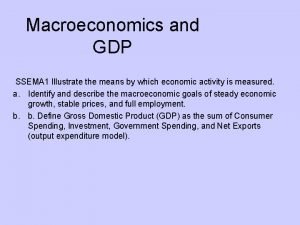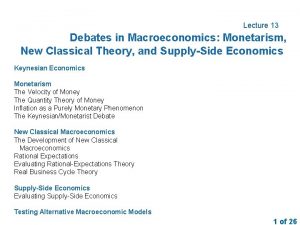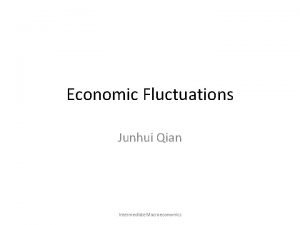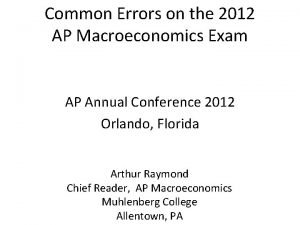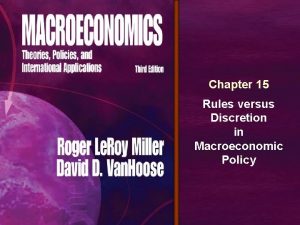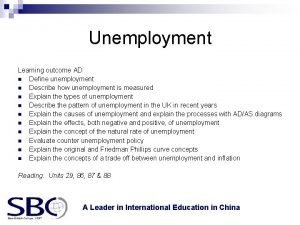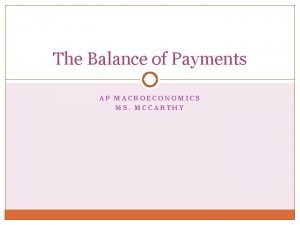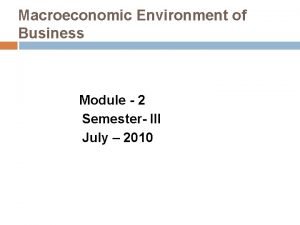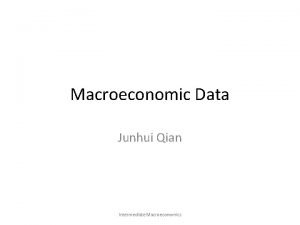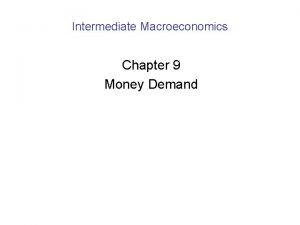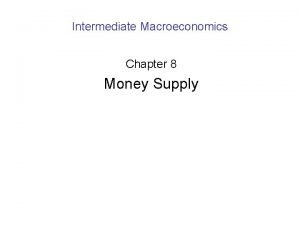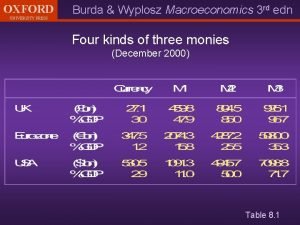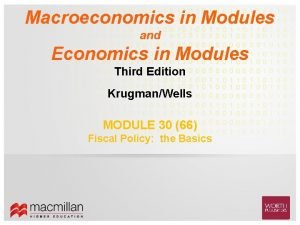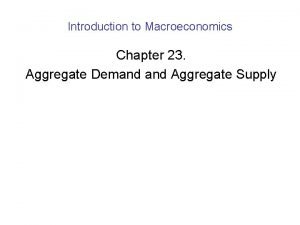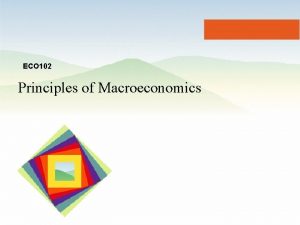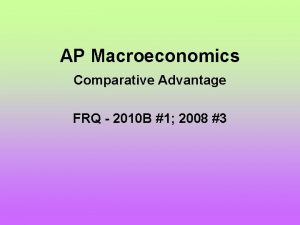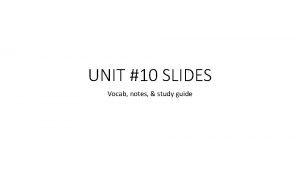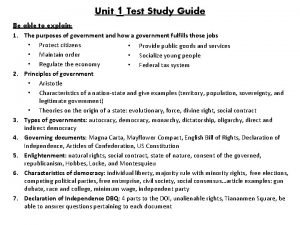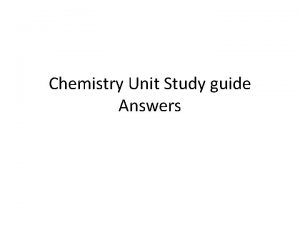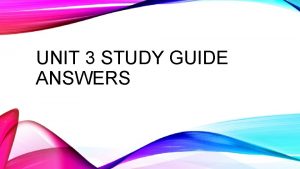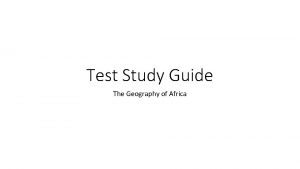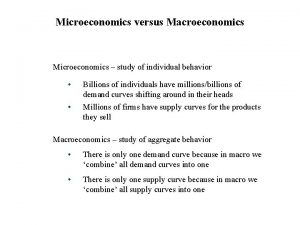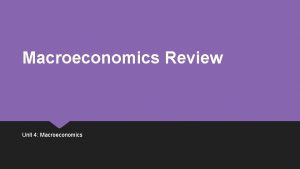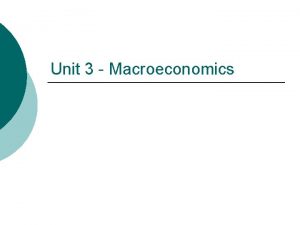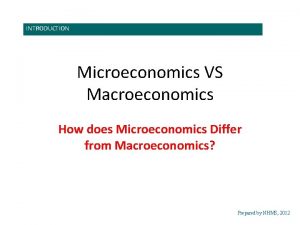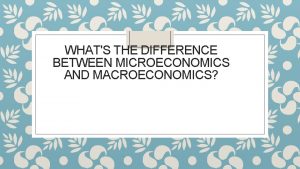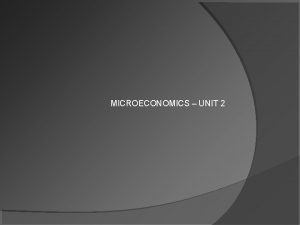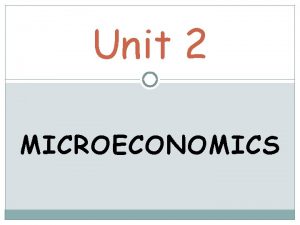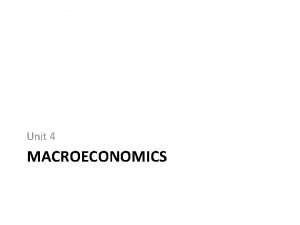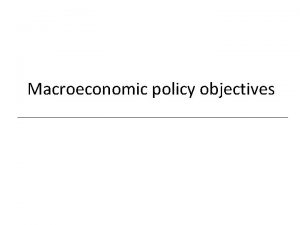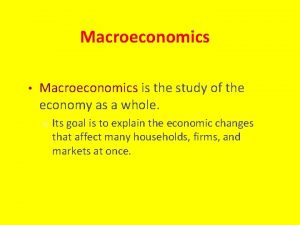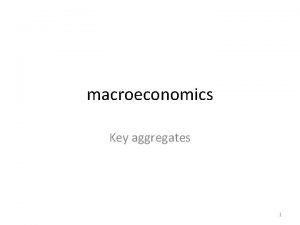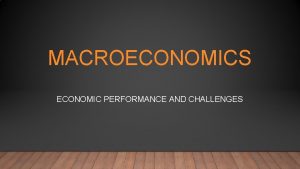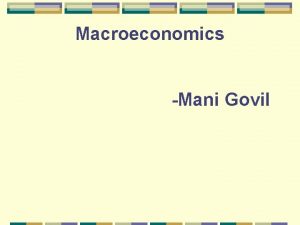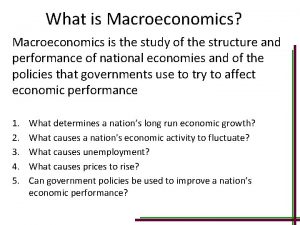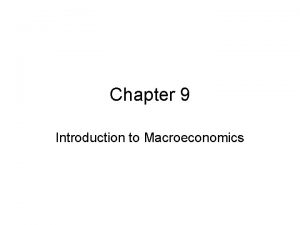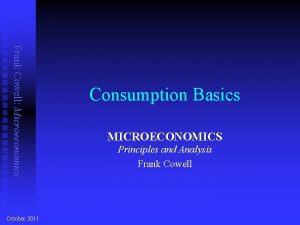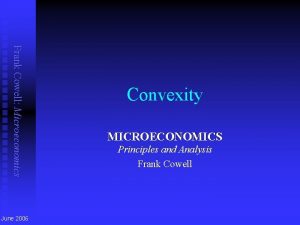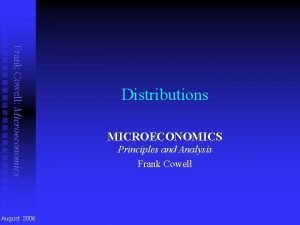Macroeconomics Unit 4 Microeconomics vs Macroeconomics Microeconomics Study


















































































































- Slides: 114

Macroeconomics Unit 4

Microeconomics vs Macroeconomics Microeconomics Study of the relationship & interaction between households (individuals), businesses, and government in the Resource and Product Markets Macroeconomics Study of the WHOLE economy The “Big Picture”

National Income Accounting System that tracks the following information: Production Consumption Savings This & investment information is used to measure the overall economic performance taking place in a country

Gross Domestic Product (GDP) The monetary value ($) of all FINAL goods and services produced within a country’s borders within a given amount of time (usually a year).

Gross Domestic Product (GDP) Foreign countries who manufacture products here in the US are also counted in the U. S. GDP because it is made here in our country.

Gross Domestic Product (GDP) The GDP is a measure of National Output (economic growth. The GDP is the most important indicator of the nation’s economy. It is computed quarterly (every 3 months)

Gross Domestic Product (GDP) Output GDP Expenditure Model Formula = C + I + G + (X – M) GDP = Consumption + Investment + Government + (Exports – Imports) (X – M) = Xn which is the net exports

Gross Domestic Product (GDP) GDP does not tell what is actually being produced & does not indicate the country’s quality of life.

4 Components of the GDP Consumption Private sector- households consuming G&S 70% of the GDP Investment Business sector investment in capital goods Investment of the business sector expands the economy in the long run 15% of the GDP

4 Components of the GDP Government Public 20% Net sector- government taxing and spending of the GDP Exports Foreign sector- includes all consumers & producers outside the U. S. - 5% of the GDP (we are in a trade deficit) (X – M) = Xn which is the calculation for the net export

What the GDP Does Not Measure Intermediate Products used to make/ produce final goods and services Secondhand Sales Ex: Sales of used goods Yard sales, Amazon, E-bay, Craig’s List

What the GDP Does Not Measure Nonmarket transactions Transactions that are not reported to the IRS Ex: babysitting, lawn care, home repairs done by the homeowner Underground economy Illegal transactions/ Black market transactions Ex: illegal drugs, prostitution, stolen goods, illegal gambling

What the GDP Does Not Measure Transfer payments Government Ex: social entitlements money redistribution programs security, SSI, welfare,

Nominal GDP measured in name only Current Does prices not adjust for inflation Nominal GDP is the price, which will continue to rise yearly due to inflation.

Real GDP expressed in fixed unchanging prices Adjusted Real for inflation GDP is the actual outputs Calculation Real GDP = __nominal price__ (price index/ 100)

Real GDP per capita Real GDP is divided by the total population & reflects each person’s share of real GDP This is the usual measure of a nation’s standard of living

Real GDP per capita Economic growth is a sustained increase in an economy’s real GDP Raises Eases the standard of living the burden on government Increasing Solves the tax base domestic and social problems Creates Lowers more jobs/ income unemployment Reduces welfare rolls Increases wages due to competition for

The Business Cycle A business cycle is a series of economic expansions & contractions over several months or years.

4 Phases of the Business Cycle Recovery/ Period expansion of economic growth that is experienced by an increase in the real GDP Peak When rising the real GDP stops

4 Phases of the Business Cycle Contraction/ Recession Economic decline in the real GDP Recession- decline in real GDP for 2 or more consecutive quarters (6 or more months) Depression- prolonged or sever recession Great depression 1930 s

4 Phases of the Business Cycle Trough Economy reaches its lowest point Real GDP stops falling “Bottomed out”

Influences on the Business Cycle Business Decisions Investments in physical capital, inventory adjustments Interest Rates & Credit Easy money vs tight money Low or high interest rates

Influences on the Business Cycle Consumer Expectations Consumer External Oil confidence in the economy factors/ Supply shocks prices Politics War Natural disasters

Types of Economic Indicators Leading indicators Indicate where the economy is going before it happens Building permits, orders for capital goods, price of raw materials

Types of Economic Indicators Coincident Reflect the current status of the economy Personal levels indicators income, sales volumes, production

Types of Economic Indicators Lagging Come indicators in after the fact Unemployment reports figures, business income

Disposable Income (DI) The money you have left to spend after paying taxes (for the Milestone) Note: In the real world, in dealing with your person budgets, this would decrease and be considered the money left over after taxes AND all BILLS have been paid.

Unemployment Labor force Total number employed and unemployed adult workers Adult non-institutionalized population Over age 16 Not in the military Not in jail or prison civilian

Who is unemployed according to the U. S. Census Bureau? People over the age of 16 who: Work for pay or profit more than 1 hour per week Have jobs but do not work due to illness, weather, vacations, etc. Work without pay in a family business for 15+ hrs. per week (unpaid family workers)

Who is unemployed according to the U. S. Census Bureau? If you do not meet any of those criteria If you were actively looking for work within the last four weeks Then you are considered unemployed!

Four Types of Unemployment Frictional Caused by movement in the economy & is always present Results from temporary transitions made by workers and employers *Being between jobs

Four Types of Unemployment Seasonal Occurs as a result of seasonal change or when industries slow or shut down for a season Life guards, Six Flags workers, migrant farmers, Christmas holiday workers

Four Types of Unemployment Structural Jobs that are permanently improvement in technology Workers Auto lost due to replaced by machines and automation industry, heavy assembly lines replaced by robots and computers

Four Types of Unemployment Cyclical Rises during recessions & economic contractions in the business cycle causing unemployment to rise This type harms the economy more than any other kind Contractions cause an increase in the unemployment % Expansions cause unemployment % a decrease in

Natural Rate of Unemployment Consists of frictional, seasonal, and structural unemployment They Are always occurring in the economy not necessarily bad Cyclical unemployment is BAD – it harms the economy more than any other kind of unemployment The gov’t may attempt to help by using expansionary fiscal policy

Poverty & Income Distribution Income distribution The way income is divided among people in a nation Income inequality Unequal distribution of income See the Lorenz curve

Poverty & Income Distribution Persistent Poverty unemployment leads to poverty threshold Official minimum income needed for the basic necessities of life in America

Poverty Rate Poverty rate is the % of people living in households that have income below the poverty threshold Approximately 35 million Americans (12. 4%) lived in poverty in 2003 By 2013, 45. 3 million Americans (14. 5%) were living in poverty The majority living in poverty are headed by single mother households.

Factors Affecting Poverty Education Higher education = higher income Discrimination Certain groups sometimes face wage discrimination or occupational segregation to find higher paying jobs Government initiatives were put in place to combat this issue (Affirmative Action)

Factors Affecting Poverty Demographic changes Increase in single-parent families has increased from 5% in the 1950 s to over 30% Divorce The rates have increased to nearly 50% change really began with the “war on poverty”

Factors Affecting Poverty Changes in the labor force Shifted from mainly manufacturing jobs to service industries Limited opportunities for low-skilled/ loweducated workers Wages in the service industries (fast food places) have never been considered a living wage and were never intended to be one prior to jobs leaving the U. S.

Government Anti-Poverty Programs LBJ declared a “war on poverty” in 1964 Promised to involve the gov’t to help reduce and & eliminate poverty in America Welfare Gov’t economic and social programs that provided assistance to the needy

Government Anti-Poverty Programs Entitlements Gov’t programs of transfer payments that redistribute tax payers’ money to those under the poverty threshold to assist with poverty Food Put Stamps in place to ensure no American would go hungry

Government Anti-Poverty Programs Medicaid Health care for the poor and is funded by federal and state governments Social Security Funded through a special payroll tax & entitles retirees a monthly check/ benefit around age 62 It is based on their last 35 years of earnings in the workforce & money already paid into the “trust fund”

Inflation General and sustained increase in the average price level of ALL products in the economy Causes money to hold less value Decreases the purchasing power of the dollar

Inflation Rate The % change in the price level from the previous period or base year Degrees of Inflation Creeping: 1 – 3% per year Walking: 3 – 10% Galloping: 10 – 30% Politically unstable Latin American countries/ former Soviet Union Hyperinflation: Extremely 50% per year rare- last step prior to monetary collapse and total ANARCHY total

Causes of Inflation Quantity Theory Excess monetary growth/ Too much money in the economy Federal Reserve allows too much money to be in circulation Decreases “Monopoly the actual value of the dollar money”

Causes of Inflation Demand-Pull Theory When aggregate demand for goods and services exceeds existing supplies Think supply and demand where the demand is higher than what can be produced causing a shortage Prices get “pulled” higher Demand- Pull is primarily caused by an increase in quantity of money in the economy

Causes of Inflation Cost- Push Theory Producers raise prices in order to meet increasing costs of inputs (resources) Unexpected Energy increase in costs examples: cost (price of oil) Labor cost (union minimum wage) Cost The demands or of raw material added costs pushes the prices up increased

Stagflation A decline in the real GDP with a rise in price levels A combination of a stagnant economy with high inflation Example: price of oil barrels rose from $5 to $35 in 1970 s (Cost push Theory at work here), and this caused a massive stagflation in our economy

Stagflation Increased cost of resources causes the Aggregate Supply (AS) to decrease and the curve to shift left. This decreased real GDP which caused a recessionary gap, increased unemployment rate, and increased price levels

Effects of Unanticipated Inflation Value of the dollar goes down, decreasing purchasing power Fixed incomes like those living on Social Security have it the hardest! People change the way they spend money; which disrupts the business cycle

Effects of Unanticipated Inflation People may take risks in the stock market In the long run, inflation favors DEBTORS over the creditors Cause: Reason the dollar loses value each year why creditors have to charge interest on loans to debtors

Consumer Price Index used to measure inflation Measures the overall cost of goods and services commonly purchased by consumers CPI = current year cost base year cost x 100

Aggregate Demand Total amount of goods and services that households, businesses, government, AND foreign purchases will buy at EVERY price level AD = C + I + G + Xn the GDP!) (Yes, it is the equation for

Aggregate Demand A change in one of the four components will cause the AD curve to shift RIGHT (increase) or LEFT (decrease) impacting the macroeconomy

Aggregate Supply Total number of goods and services that PRODUCERS will provide at each and EVERY price level A change in the input costs, technology/ productivity, or business taxes/ regulations/ subsidies will cause the AS curve to shift right (increase) or left (decrease)

LRAS Long-run Aggregate Supply (LRAS) is the vertical line where AD and AS intersect at the equilibrium and demonstrates an efficient economy operating at full employment (95%) or at the natural rate of unemployment (5%)

LRAS AD/AS Graph AD If you had an increase in capital goods by the business sector, it would shift to the RIGHT

LRAS AD/AS Graph AD The rightward shift marks economic growth by an increase in the real GDP, but also inflation due to an increase in price level

LRAS AD/AS Graph AD A leftward shift would be due to something like a trade deficit (Xn) where the result would be a decrease in the real GDP

LRAS AD/AS Graph AD This would cause the unemployment rate to increase, but price levels to decrease

LRAS AD/AS Graph AS If you had increased productivity due to better technology, what would happen?

LRAS AD/AS Graph AS The graph would shift right It would cause an increase in supply AND the real GDP Price down levels would go

LRAS AD/AS Graph AS If there was a cost increase in the energy prices, what would happen?

LRAS AD/AS Graph AS The graph would shift to the left The real GDP would decrease, causing a recession

LRAS AD/AS Graph AS Unemployment would increase Price levels would increase This would be an example of a stagflation and is BAD for the macroeconomy

Money Used is the most basic of all financial assets to buy goods and services

Three FUNCTIONS of Money Medium of Exchange Buyers give money to sellers in exchange for G&S Unit of Account Expression A of value way of comparing the values of G&S Store of Value Money holds its value IF you decide to store it instead of spend it

2 TYPES of Money Commodity Money Item Money with an alternate use as a commodity still has value if not used as money Examples: gold, silver, cigarettes (WWII), tulip bulbs in 1600 s Europe

2 TYPES of Money Fiat Money Considered money by “order/ decree” Government issued money Examples: paper dollars, money that is intrinsically worthless (not worth anything unless the government says it is) The U. S. uses fiat money because we are no longer on the gold standard

Legal Tender Money that a government has required to be accepted in settlement of debts

Money in the USA Liquidity Ease with which an asset can be converted into money Liquid- checking account (if you have the funds, you can take money out) Non-liquid- your house (if you own it); cannot be immediately sold and turned into money

Money in the USA M 1 Money that people can gain access to easily and immediately High liquidity checking accounts travelers checks

Money in the USA M 2 Consists of all the assets in M 1 plus assets that are not as liquid (near-monies) Slightly less liquid Savings accounts Money markets Mutual funds

CHARACTERTSTICS of Money Durability Must withstand physical wear and tear that is a part of being used over and over again Portability People need to be able to take money with them from place to place

CHARACTERTSTICS of Money Divisibility Money must be easily divided into smaller denominations Stability Money’s purchasing power (value) should be relatively stable Think of our Rev. War soldiers and Shay’s Rebellion where money was not worth the paper it has been printed on

CHARACTERTSTICS of Money Uniformity Money must be uniform Must be easy to count Must be easy to measure Limited Money Supply/ Scarcity supply must be kept in limited supply

CHARACTERTSTICS of Money Acceptability Everyone in an economy must be able to exchange the objects that serve as money Early years before the FED had banks and regular people making their own money This meant the further away from the issuing bank, the less value the “money” held

Monetary Policy and the FED Monetary policy Directly affects the nation’s money supply Influence Money needs the cost and availability of credit supply expands or contracts based on

Monetary Policy and the FED The Federal Reserve The It “FED” is the central bank of the U. S. Created by Congress with the Federal Reserve Act of 1913 Central bank Institution Oversee designed to do two things: the banking system Regulate the quantity of money in the economy

Monetary Policy and the FED Structures Central It of the FED Bank is located in Washington, D. C. is run by a 7 member Board of Governors Appointed by the President of the U. S. Confirmed by the Senate Serve a 14 year term

Monetary Policy and the FED The Board is led by the Chairman of the FED The current chair is Janey Yellen Appointed by Pres. Obama in 2013

Monetary Policy and the FED is comprised of 12 Federal District reserve Banks One federal Reserve bank for each district They monitor economic and banking conditions in their district

The Federal Open Market Committee FOMC 7 member Board of Governors plus the president of the FED of NY are the permanent members 4 out of the other 11 regional bank president rotate on a yearly basis

The Federal Open Market Committee FOMC Holds 8 regularly scheduled meetings a year Monitors All the money supply 12 attend, but only 5 vote The President of NY Fed ALWAYS votes New York is the financial capital center of the world They are voting on whether to increase or decrease the money supply

FED’s 3 Tools of Monetary Control First Tool- Open Market Operations Purchase and sale of US gov’t bonds by the FED This is the most often used method to control the money supply because it has an immediate effect To increase money supply- FED buys bonds from the banks and credits the banks with money

FED’s 3 Tools of Monetary Control Easy-Money Policy Expansionary Goal money policy is to expand the economy by: Lowering interest rates Encouraging banks to lend money to consumers Discouraging savings This Policy all works to increase the money supply is used to stimulate the economy

FED’s 3 Tools of Monetary Control Easy-Money Policy (cont. ) Policy is used to stimulate the economy by promoting business investments and consumer spending To decrease the money supply: FED sells bonds to the banks and withdraws money from the banks

FED’s 3 Tools of Monetary Control Tight Money Policy Contractionary The monetary policy goal is to slow the economy by: Raising Cause interest rates inflation to slow Discourage borrowing Encourage saving Restricting the money supply

FED’s 3 Tools of Monetary Control Tight Money Policy (cont. ) Policy slows down business activity & investments Stabilizes Result prices is a reduction in aggregate demand Hint: BUY BIG = expansionary SELL SMALL = contractionary

Last Day of Notes for this Unit!

FED’s 3 Tools of Monetary Control Second Tool- Reserve Requirements Regulations on the minimum amount of reserves that banks must hold against deposits Fractional Reserve System Banks hold a fraction of deposit reserves as opposed to 100% reserve system This is how banks “create” money

FED’s 3 Tools of Monetary Control Banks must have a supply of funds to protect against Bank runs Panics (Like what happened prior to the Great Depression) Current 10% Requirement on liquid money (M 1)- checking accts, traveler’s checks

FED’s 3 Tools of Monetary Control Reserve requirements influence how much money banks can create from each deposit Decrease money supply Increase Banks Can reserve requirement hold out more for reserves loan out less money

FED’s 3 Tools of Monetary Control Reserve requirements influence how much money banks can create from each deposit Increase money supply Decrease Banks Can reserve requirement hold out less for reserves loan out more money

FED’s 3 Tools of Monetary Control Third Tool- Discount rate Interest rate on loans the FED charges its member banks (not average people on the street) FED is the lender of last resort

FED’s 3 Tools of Monetary Control Banks borrow from the FED when: It has too many loans It has low reserves Has high withdrawals Lower discount rate encourages borrowing Higher discount rate discourages borrowing

Fiscal Policy & Gov’t Spending Congress and the president must agree on a federal budget Federal gov’t spends trillions of $ each year on: Resource Income Public allocation redistribution G&S Becoming a major factor macroeconomy (global economy) in the

Fiscal Policy & Gov’t Spending Crowding Out Effect Federal That gov’t borrows money means there is less money to borrow for the private sector

Fiscal Policy & Gov’t Spending Mandatory Spending required by current law Entitlements Social Security Medicare Medicaid Food Stamps Unemployment

Fiscal Policy & Gov’t Spending Discretionary Spending More Spending the gov’t must authorize each year than 1/3 of the federal revenue Interstate highways, national parks, space & research, FBI, etc. Our national defense is the largest expenditure (about 50%)

Fiscal Policy & Gov’t Spending Fiscal policy Federal gov’ts use of taxes & gov’t spending to affect the economy Fiscal policy is looking to do one of two things for the economy: Speed Slow it up (Hit the gas!) it down (Brake!)

Fiscal Policy & Gov’t Spending 2 Goals of Fiscal Policy Increase Fight aggregate demand (AD) inflation

Fiscal Policy & Gov’t Spending Economy Gov’t in a recessionary period may use expansionary fiscal policy Increase AD Stimulate This a weak economy means increase gov’t spending and/ or decrease taxes

Fiscal Policy & Gov’t Spending Economy Gov’t in an inflationary period may use contractionary fiscal policy Reduce AD Slow the economy in a period of toorapid expansion This means decrease gov’t spending and/ or increase taxes

Fiscal Policy & Gov’t Spending Discretionary fiscal policy Involves the gov’t taking actions to correct economic instability Congress The may pass a law gov’t takes an action that affects the microeconomy

John Maynard Keynes Developed a revolutionary idea of how to change discretionary fiscal policy

Keynesian Economics Great Depression Changed economists mins on the role of gov’t in the economy (Discretionary fiscal policy)

Keynesian Economics Keynesian economics Believes AD that in times of RECESSION needs to be stimulated action Forms by gov’t the basis of demand-side fiscal policy (expansionary fiscal policy)

Keynesian Economics Expansionary Attain Gov’t fiscal policy idea full employment plays an active role in the economy

Keynesian Economics This new idea challenged economists like Adam Smith (from unit 1) and other classical economists who believed in: Limited Laws gov’t of supply and demand should drive the economy

Keynesian Economics Negatives of Keynesian Economics: Excessive AD due to gov’t or consumer spending can lead to inflation and national debt When the country experiences stagflation, demand side policies are ineffective

National Debt Clock http: //www. usdebtclock. org/
 Macroeconomics vs microeconomics venn diagram
Macroeconomics vs microeconomics venn diagram Venn diagram of macroeconomics and microeconomics
Venn diagram of macroeconomics and microeconomics Ap microeconomics unit 1 basic economic concepts
Ap microeconomics unit 1 basic economic concepts Contractory monetary policy
Contractory monetary policy Ap macro unit 3
Ap macro unit 3 Unit 6 review questions
Unit 6 review questions Copy
Copy What is the subject matter of microeconomics
What is the subject matter of microeconomics What is microeconomics
What is microeconomics Intermediate microeconomics lecture notes
Intermediate microeconomics lecture notes Intermediate microeconomics notes
Intermediate microeconomics notes Oligopoly model
Oligopoly model Walras law in economics
Walras law in economics Externalities and public goods microeconomics
Externalities and public goods microeconomics Almost essential
Almost essential Parkin macroeconomics 13th edition pdf
Parkin macroeconomics 13th edition pdf Objective of microeconomics
Objective of microeconomics Microeconomics
Microeconomics Microeconomics
Microeconomics Uses of microeconomics
Uses of microeconomics Example of macroeconomics
Example of macroeconomics Microeconomics chapter 12
Microeconomics chapter 12 Cowell microeconomics
Cowell microeconomics Almost essential
Almost essential Microeconomics examples
Microeconomics examples Circular flow diagram menggambarkan
Circular flow diagram menggambarkan Game theory microeconomics
Game theory microeconomics Cowell microeconomics
Cowell microeconomics Almost essential
Almost essential Cowell microeconomics
Cowell microeconomics Frank cowell
Frank cowell Cowell microeconomics
Cowell microeconomics Microeconomics ia
Microeconomics ia 22rents
22rents What is case series
What is case series Retrospective cohort study
Retrospective cohort study What is work study in management
What is work study in management Marty lobdel
Marty lobdel Phytogeographical regions
Phytogeographical regions Objective of work study
Objective of work study Time and motion study example ppt
Time and motion study example ppt Macroeconomics
Macroeconomics Crowding out effect macroeconomics
Crowding out effect macroeconomics Crowding out effect macroeconomics
Crowding out effect macroeconomics Definition managerial economics
Definition managerial economics Recessionary gap
Recessionary gap Nominal gdp formula
Nominal gdp formula New classical macroeconomics
New classical macroeconomics New classical macroeconomics
New classical macroeconomics Crowding out effect
Crowding out effect 2012 macroeconomics frq
2012 macroeconomics frq Calculate gdp circular flow diagram
Calculate gdp circular flow diagram Ap macroeconomics-percentage for a 5
Ap macroeconomics-percentage for a 5 Chapter 31 open economy macroeconomics
Chapter 31 open economy macroeconomics Macroeconomics deals with:
Macroeconomics deals with: Supply side economics
Supply side economics New classical and new keynesian macroeconomics
New classical and new keynesian macroeconomics Ap macroeconomics cheat sheet
Ap macroeconomics cheat sheet Ap macro graphs
Ap macro graphs Macroeconomics
Macroeconomics Macroeconomics lesson 3 activity 46
Macroeconomics lesson 3 activity 46 The components of macroeconomics
The components of macroeconomics Macroeconomics mankiw 9th edition
Macroeconomics mankiw 9th edition Macroeconomics review
Macroeconomics review Macroeconomics chapter 7
Macroeconomics chapter 7 Macroeconometrics
Macroeconometrics Real gdp formula
Real gdp formula Macroeconomics chapter 8
Macroeconomics chapter 8 Macroeconomics
Macroeconomics Seasonal unemployment example
Seasonal unemployment example Site:slidetodoc.com
Site:slidetodoc.com Macroeconomics
Macroeconomics Macroeconomics
Macroeconomics Nicepp
Nicepp Macroeconomics
Macroeconomics Macroeconomics
Macroeconomics Principles of macroeconomics case fair oster
Principles of macroeconomics case fair oster Macroeconomics theory and practice
Macroeconomics theory and practice Macroeconomics
Macroeconomics Macroeconomics definition economics
Macroeconomics definition economics Gross domestic product macroeconomics
Gross domestic product macroeconomics Macroeconomics
Macroeconomics Intermediate macroeconomics mankiw
Intermediate macroeconomics mankiw Macroeconomics
Macroeconomics 2012 ap macroeconomics free response answers
2012 ap macroeconomics free response answers Macroeconomics
Macroeconomics Rules vs discretion macroeconomics
Rules vs discretion macroeconomics Unemployment diagram
Unemployment diagram Definition of fiscal policy
Definition of fiscal policy Ap macroeconomics balance of payments
Ap macroeconomics balance of payments What are open market operations
What are open market operations Macroeconomics
Macroeconomics Significance of macroeconomics
Significance of macroeconomics Junhui qian
Junhui qian Money demand
Money demand Macroeconomics
Macroeconomics New classical and new keynesian macroeconomics
New classical and new keynesian macroeconomics Tourism macroeconomics
Tourism macroeconomics Burda and wyplosz
Burda and wyplosz Macroeconomics in modules
Macroeconomics in modules Vertical supply curve
Vertical supply curve Macroeconomics
Macroeconomics Ap macroeconomics frq 2010
Ap macroeconomics frq 2010 Unit 10 study guide answer key
Unit 10 study guide answer key Unit 1 study guide answer key
Unit 1 study guide answer key Hydrology unit study guide
Hydrology unit study guide Temperate zone
Temperate zone English test unit 2
English test unit 2 Chemistry unit 1 study guide
Chemistry unit 1 study guide Pythagorean theorem study guide answer key
Pythagorean theorem study guide answer key Unit 3 study guide answers
Unit 3 study guide answers Ap gov unit 1 study guide
Ap gov unit 1 study guide Africa geography unit test study guide
Africa geography unit test study guide Ap psych unit 6 study guide
Ap psych unit 6 study guide Module 74 ap psychology
Module 74 ap psychology


